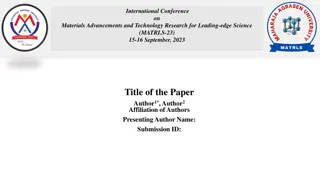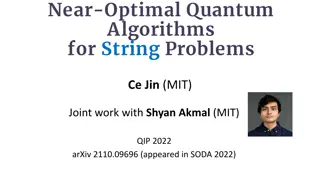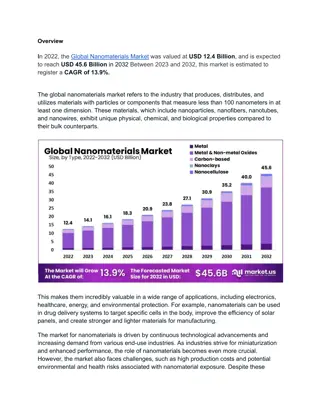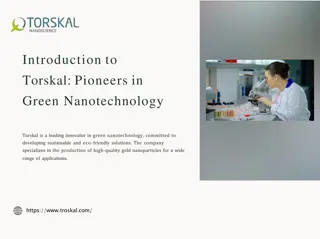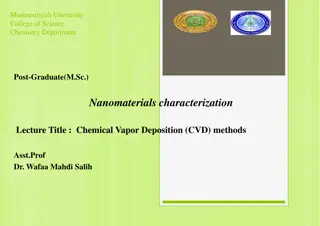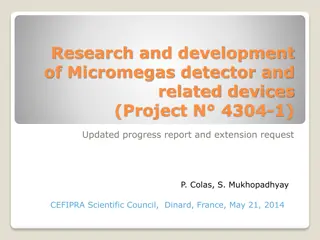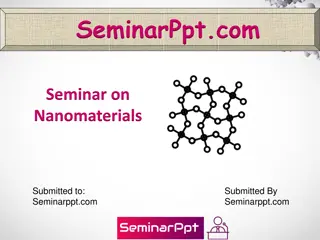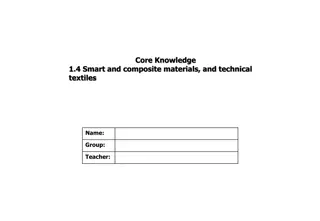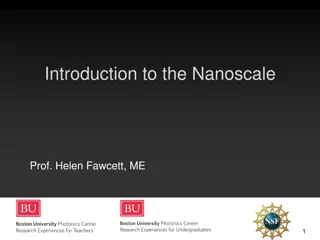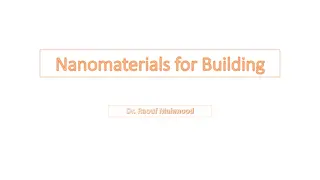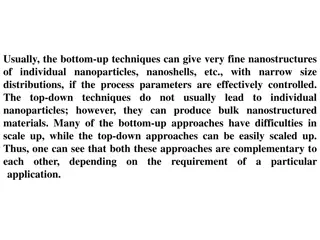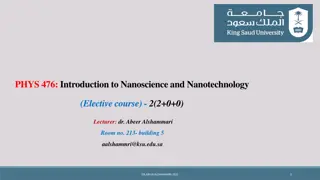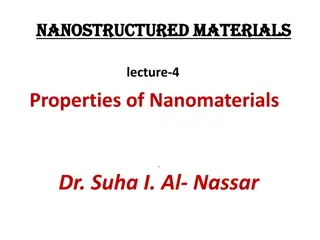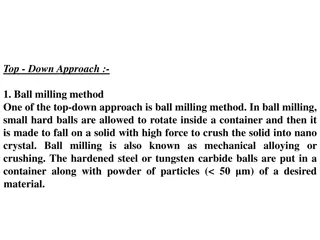Advancements in 2D Nanomaterials Research
Advancements in the field of 2D nanomaterials, beyond graphene and transition metal dichalcogenides (TMDs), have attracted significant attention. Researchers explore various 2D materials with unique properties and applications. The categorization of 2D materials into layered and non-layered structures impacts synthesis methods. Exfoliation and epitaxial growth are key techniques discussed by experts to prepare and manipulate 2D materials for diverse applications, such as electronics and catalysis. The structure-property-application relationship in the 2D family is a key focus area, highlighting their electronic properties, surface area, processability, and functionalities.
Download Presentation

Please find below an Image/Link to download the presentation.
The content on the website is provided AS IS for your information and personal use only. It may not be sold, licensed, or shared on other websites without obtaining consent from the author.If you encounter any issues during the download, it is possible that the publisher has removed the file from their server.
You are allowed to download the files provided on this website for personal or commercial use, subject to the condition that they are used lawfully. All files are the property of their respective owners.
The content on the website is provided AS IS for your information and personal use only. It may not be sold, licensed, or shared on other websites without obtaining consent from the author.
E N D
Presentation Transcript
2D nanomaterials: beyond graphene and transition metal dichalcogenides Chemical Society Reviews, 47, 2018, 6009 Hua Zhang, Hui-Ming Cheng and Peide Ye Guest Editors
Graphene and transition metal dichalco-genides (TMDs), as typical two-dimensional (2D) nanomaterials, have impressed the research community owing to their unique structural features, fascinating physio- chemical properties, and promising applications in diverse fields. More significantly, the success of graphene and TMDs has inspired researchers to explore many other 2D nano- materials. Though possessing a similar sheet-like structure as graphene and TMDs, these 2D nanomaterials can own strikingly different properties, rendering them attractive in various research and application fields
The 2D family can be categorized into two types layered and non- layered material structures. This structural difference directly affects the applicability of different synthesis methods. In general, top-down methods, i.e., various types of exfoliation strategies, are mainly applicable to layered materials, while bottom-up methods, including chemical vapor deposition (CVD) and wet-chemical synthesis, are more versatile and, in principle, applicable to prepare all 2D nanomaterials.
Besides, Hui-Ming Cheng and co-workers (DOI: 10.1039/C8CS00254A) specifically focus on the utilization of exfoliation methods to prepare a collection of 2D material dispersions. They introduce different exfoliation methods and highlight their merits and limits. Then, they discuss the assembly of exfoliated 2D materials into macrostructures by solution-based strategies. Their wide applications are also overviewed, such as electronics, electro- catalysis
Hong-Jun Gao and co-workers (DOI: 10.1039/C8CS00286J) target the preparation of novel 2D materials (including both the monatomic and binary 2D materials) by epitaxial growth under ultra-high vacuum conditions. In particular, they highlight various synthesis strategies such as inter-calation, templated molecular adsorption, direct selenization and tellurization of metal substrates. Besides, they also emphasize the intriguing physical properties exhibited by these 2d Materials
In addition to synthesis, the structure propertyapplication relationship of the 2D family is another hot research focus. Due to the structural similarity, the 2D family shares plenty of merits, such as intriguing electronic properties owing to the electron confinement in two dimensions, ultra-high specific surface area, solution-based processability, surface functionalities and so on. Here,WarrenL.B.HueyandJoshuaE. Goldberger (DOI: 10.1039/C8CS00291F) summarize recent progress in the surface functionalization chemistry of 2D materials. The highly exposed surface atoms possessed by 2D materials render them easy to be functionalized. They particularly focus on the covalent functionalization of 2D group 14 graphene analogues, such as Si, Ge, and Sn analogues of graphene, in which every atom requires a terminal ligand for stability. Furthermore, they highlight the influence of covalent functionalization on the electronic structure, optical properties and thermal Stability.
Despite the similarity, 2D nanomaterials also possess their own characteristic compositions, crystal structures and properties, offering a vast selection of materials for a given application.
Wei Huang and co-workers (DOI: 10.1039/C8CS00332G) review plenty of 2D light-emitting materials (e.g.,TMDs,phos-phorene, 2D perovskites and MOFs), which are categorized into three groups, namely 2D inorganic, 2D organic and 2D organic inorganic hybrid light-emitting materials. Diverse synthesis methods are introduced for each group of materials; different strategies are highlighted to modify their luminescent properties, such as engineering the number of layers or dielectric environment, and construction of alloys or van der Waals (vdW) heterostructures. Furthermore, applications of these 2D light-emitting materials in lighting, imaging and sensing are discussed
Lianzhou Wang et al.(DOI: 10.1039/C8CS00396C) focus on the unique physico-chemical properties of 2D semiconducting light absorbers and their applications in photocatalysis. The intriguing structure property relationship is highlighted, elucidating the interplay among their electronic structures, optical absorption and spatial separation of charge carriers. Besides, typical 2D light absorbers are discussed in detail from the aspects of their structural and compositional features, defect engineering, heteroatom doping and construction of hybrid structures.
Xiangfeng Duan and co-workers (DOI:10.1039/C8CS00318A) overview the exploration of novel 2D semiconductors for applica- tions in ultra-thin body transistors.Considering graphene transistors which are limited by a zero bandgap and low ON OFF ratio, and TMD devices which are limited by insufficient carrier mobility, novel 2D semiconductors with optimum electronic properties are extremely desirable. To this end, this article offers a comprehensive discussion on the advantages and disadvantages of diverse 2D transistors beyond graphene and TMDs.
Jun He and co-workers (DOI: 10.1039/C8CS00255J) target the applications of novel 2D materials as photodetectors, highlighting their fascinating properties, such as wide bandgap coverage, direct bandgap independence with thickness, high mechanical flexibility and new photo-response phenomena. The detailed photo- detections based on both layered and non-layered 2D materials are comprehensively summarized. Besides, photodiodes and hybrid phototransistors based on the heterostructures of these novel 2D materials are also introduced. In addition, the integration of these 2D materials with flexible substrates is highlighted
Instead of addressing many 2D nano-materials in one article, the following review articles focus on a specific 2D nanomaterial
Akinwande Deji and co-workers (DOI: 10.1039/C8CS00338F) present a review on silicene, a 2D allotrope of silicon with a hexagonal honeycomb structure. Problems such as material degradation and process portability have limited the experimental studies on silicene. Tar geting this issue, this review summarizes experimental progress in synthesis, characterization, stabilization, processing and device applications of silicene and silicene derivatives. Specifically, they highlight the electronic properties of silicene, which are sensitive to various factors such as substrate inter-action, surface chemistry and spin orbit coupling. More importantly, studies related to the material and processing aspects ofsilicene can also shed light on research of other Xenes including stanene, germanene, phosphorence and so on
Hyun-Seok Lee and co-workers (DOI: 10.1039/C8CS00450A) review recent progress in studies related to hexagonal boron nitride (hBN). Unlike graphene as a metal and TMDs as semiconductors or metals, hBN is a dielectric, serving as a promising compo- nent in 2D vdW electronics. Nevertheless, its electronic applications have been limited to microscale sizes. Hence, this review highlights the large-area synthesis of hBN and hBN-based hetero-structures Via the CVD method. Besides, applications of hBN in 2D electronics are discussed from various aspects, such as charge fluctuation, passivation, gate dielectrics, tunnelling, Coulomb inter-actions and contact resistance.
Letian Dou and co-workers (DOI: 10.1039/C7CS00886D) gi ve a comprehensive review on 2D halide perovskite nano-materials. They summarize the synthesis strategies and characterization techniques of 2D halide perovskite nanostructures. Besides, their heterostructures with other 2D materials including graphene and TMDs are discussed, with emphasis on their interface studies. Furthermore, thanks to the long charge carrier lifetime, high photoluminescence quantum efficiency and excellent defect tolerance of 2D halide perovskites, their promising applications in optoelectronic devices are also highlighted
Xun Wang and co-workers (DOI: 10.1039/C8CS00113H) present a review on multimetallic nanosheets. They sum- marize various synthesis approaches with precise control over their size, thickness, shape and composition. Superior to their bulk counterparts and nano-structures with other dimensionalities, 2D multimetallic nanosheets are highly attractive in fuel cell applications, owing to their ultra-high specific surface areas and high surface energy, so the electro- catalytic performances of various multi-metallic nanosheets are summarized.
Hua Zhang and co-workers (DOI: 10.1039/C8CS00268A) focus on 2D metal organic framework (MOF) nanosheets. They comprehensively summarize various synthesis strategies to prepare 2D MOF nanosheets, including top-down and bottom-up methods. Besides, they present the recent progress in work related to 2D MOF nanosheet-based nanocomposites. Furthermore, their applications in diverse fields such as gas separation, energy conversion and storage, sensors and biomedicine are introduced
Graphene and TMDs: shows no end In spite of the research boom in various novel 2D nanomaterials, graphene and TMDs still hold the leading role and are always active in the research community. Steps towards obtaining a deep and com- prehensive understanding of their structures and properties and achieving their ultimate commercialization never stop. Jin Zhong Zhang and co-workers (DOI: 10.1039/C8CS00314A) review recent progress in 2D MoS2 and MoS2-based hetero- structures. They summarize diverse synthesis strategies and highlight the correlation between the structures and their electronic and optical properties. In addition, applications of MoS2-based 2D materials in light energy harvesting and conversions fields are considered
Sang Ouk Kim and co-workers (DOI: 10.1039/C8CS00299A) present a review on research related to graphene oxide liquid crystals (GOLCs). They summarize the synthesis approaches and highlight several experimental parameters for optimizing GOLC formation. The intriguing physical properties of GOLCs, such as rheological, magnetic and electro-optic properties, are discussed. They provide an overview of the characteristics of different types of GOLC phases, including nematic, lamellar and chiral phases. Furthermore, progress in designing GOLC-based functional materials and their applications in diverse fields are introduced
2D nanomaterials beyond graphene and TMDs: The future The past decade has witnessed the rise and great progress of novel 2D nano- materials beyond graphene and TMDs. Nevertheless, they are still in their infancy and deserve great research efforts. From the viewpoint of synthesis, developing various synthesis methods to prepare novel 2D nanomaterials with precise control over their size, thickness, crystallinity, crystal phase, surface property, strain, defect and doping is of paramount importance. Further more, high-yield and mass production of 2D nanomaterials with satisfactory quality is always pursued for achieving ultimate industrialization. From the characterization point-of-view, developing high-end and in situ characterization techniques to unveil the structures of various 2D nanomaterials and uncover their growth mechanisms is critically important for fundamental studies. From the view-point of applications, since every material as their own merits and drawbacks,constructing hybrids of distinct 2D nanomaterials may hold the key for performance enhancement. Moreover, the synergy among different components in a hybrid may even bring about unexpected effects.
Finally, I believe this compilation of these excellent review articles, researchers from diverse fields will get a broader and deeper understanding of 2D nanomaterials. I do hope that the next decade will witness more exciting research milestones in this area.




